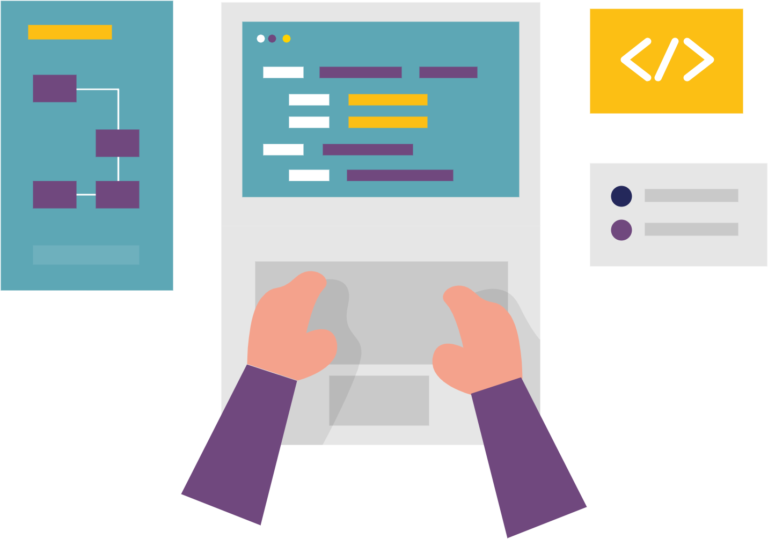
Systems Integration for E&P
Creating a well master helped one client get control of their data.Read More
Looking for custom software development services?
Whether you are an innovator eager to build something amazing & new or an IT leader responsible for modernizing an aging application, our custom software development experts can help.





We love to code. As our team has evolved over the past 12 years, as we’ve changed faces and offices, the one constant has been the presence of a robust software development practice.


If a commercially available product exists that already does exactly what you need it to do, it will almost always be less expensive to purchase that product then to develop something from scratch. Our clients make use of our custom software and mobile app development services when commercially available software products don’t meet their unique business needs.
Think about your business. What do you tell people when they ask, “what makes you different”? In some industries, you can make a living following common practices and doing things pretty much the same as everyone else, but sustained above-average performance comes from doing things differently in a way that your customers find valuable.
The problem with commercially available Software as a Service (SaaS) or off-the-shelf (OTS) offerings is that they are (by definition) available to everyone, meaning they can’t support a differentiated business model without at least some customization. The more general the piece of software, or the more differentiated the business model, the more customization will be needed.
Eventually, you reach a point where a widely-available piece of software just won’t cut it, and you have to either build something from scratch, combine some custom code with standard services, or extend a platform by building a custom app on top of it.
Getting systems to talk to one another is critical if you want to do things like automate a business process end to end or establish systems of record for your key data that other systems draw from.
While integrations are on the market for many popular systems, especially cloud-based tools, you sometimes run across systems for which there is not an integration either built-in or available for purchase. This problem is compounded when you have an ecosystem of software all needing to communicate. In these cases, custom software can be used to bridge the gap and get all the systems playing nicely.

There are several ways to go about getting your custom software developed. As consultants, we may be a little biased about which way is best, but the truth is that it’s not always the best decision to engage a consultancy to get the work done. Here are some common service structures with pros and cons for each.
Today, people expect easy access to the data they need to do their job and the ability to quickly interact with vendors on their terms in a self-service environment. Customer portals deliver on all of these points and keep you on the leading edge in your industry.

Custom Software Development Consultancies like Entrance bring together top-notch professionals to take on projects for clients. The nice thing about this model is that you reliably get experts that are good with people, not just computers. Since we work as a group, you don’t have to worry about a custom software project grinding to a halt if someone gets sick. We can get things done very quickly, and if there’s a technical challenge we can turn to the experts in the organization for help.
The downside of using a custom software development consultancy is that it can be overkill. We employ the best and thrive on solving really tough challenges. If you have a mundane problem and just need a body to execute on an already-defined plan, hiring someone like us will cost way more than you need to pay. In this case, you’re better off with a freelancer or a contractor.

Freelancers usually work alone either as their full-time gig or as a second job. They vary in expertise, which can make it tough to separate the bad from the good, but online freelance marketplaces often show ratings to help buyers judge the skills of the candidate.
Freelance custom software developers are good for smaller jobs that can be taken on by one person, especially if that job requires specialized expertise. If they need help with a technical problem, they can typically turn to their network for assistance. Oftentimes, a portion of the payment for the job is withheld until after the work is delivered, so the risk to the buyer of the freelancer not completing the work is lessened.

Firms in this category recruit custom software development professionals and then hire them out to buyers, typically in staff augmentation arrangements. They are essentially a broker, bringing together personnel and employers and charging a fee for every hour worked.
Contractors are good for well-defined jobs where you don’t mind providing supervision and direction. You are paying for their time like you would a regular employee, and they will need direction just like a regular employee would. If this is what you’re looking for, this route is usually the least expensive of the three.
The downside of this arrangement is that the contractors may spend most of their time onsite with clients, and may not have deep connections with others at their firm or with independent technical experts. This means that, if they run into trouble, they may not have someone they can quickly turn to.
Another downside is that custom software development contractors, depending on their experience, typically have an employee mindset, meaning they do what they are told to the best of their abilities. Unlike consultants or freelancers, they may not be looking out for the overall wellbeing of the project.
We follow a standard process for custom software development. It’s an adaptation of the Microsoft Solutions Framework that
incorporates Scrum into the Build portion of the framework.
Build vs. Buy
Although we’re working all the time to drive down the costs, we have no problem admitting that enterprise-grade custom software development can be a big investment. That is why, before committing to developing something from scratch, we always make sure that our clients have a good handle on what business value the project is intended to deliver. This helps establish the maximum investment that should be made, and prevents you from moving forward with an ill-advised project.
It’s possible that custom software development is not the way to go, so a Build vs. Buy assessment should be conducted. Our clients often get us involved at this stage in the process, as we have experience performing these types of assessments.
Envision & Plan
We usually split our custom software development projects into two parts, of which Envision and Plan (E&P) is the first part.
During the E&P phase, we lay out the high-level features to be developed, the business value that will be delivered, the architectural design, and the plan for the upcoming build phase.
The deliverables for this phase are the Vision and Scope document, which contains the elements described above as well as a prioritized product backlog, which is just a list of work to be performed during the build phase.
Build, Stabilize & Deploy
During this phase, the team turns the Vision and Scope document into working software. We take an agile approach, demonstrating working software to you every two weeks, and allowing you to re-prioritize the remaining scope so that we are always working on the most valuable feature.
It’s up to you if you would like our team to handle things like training and documentation, or if you would like to have your employees handle some of this work. We are more than happy to do this for you, but our clients often take this on to reduce the cost of the project.
Maintenance
All software needs a certain amount of maintenance to address small tweaks that users want, corner-case bugs that were not identified during testing, and upgrades necessary to allow the software to play nicely with other systems.
For this reason, we always work with our clients to estimate the amount of maintenance time that will be needed and put in place a support contract. We offer low-cost retainer packages that allow us to respond quickly to maintenance events and even use the leftover hours for system enhancements.
Custom software development is the process of designing, creating, deploying and maintaining software for a specific set of users, functions, or organizations. It involves building a software that’s tailored to meet specific user requirements, which cannot be fulfilled by off-the-shelf software.
Custom software development services are needed by businesses that have unique needs which cannot be addressed by commercially available software. Businesses requiring specific functions, features, or integrations which aren’t offered by ready-made software often opt for custom software development. If employees are spending a lot of time on repetitive tasks, if there are gaps in accessing relevant information for decision-making, or if there’s a need for mobile access to key information, custom software can be the solution.
Custom software, also known as bespoke software, is a type of software that is specially developed for a specific user or a group of users within an organization. It is designed to address their needs precisely as opposed to the more traditional off-the-shelf software.
Examples of custom software could include a custom CRM system designed for a specific sales process, a custom app developed to manage the unique logistics of a business, a bespoke reporting system built to present data in a specific format, or a tailored inventory management system that’s designed to work with unique business workflows.
Custom software development is better because it allows businesses to digitize their unique processes, leading to increased efficiency and productivity. The software can be tailored to fit exactly how a company operates and can evolve as the company grows or changes its processes. It provides an opportunity to maintain a company’s unique identity and competitive advantage.
The cost of custom software development can vary widely depending on the scope and complexity of the project, the technologies involved, and the resources required. However, with our lightweight, low-cost toolset, you can save tens of thousands on licensing, hosting, and maintenance costs compared to a traditional on-premises stack.
When choosing a custom software development company, look for a company with a proven track record, industry expertise, and high customer satisfaction scores. Ensure they use a proven development process, can deliver results in a timely manner, and have a robust maintenance and support system in place.
Hiring a custom software development company gives you access to a team of experts who have broad experience in the industry. These professionals can provide a fresh perspective and can tackle complex technical challenges efficiently. They can also ensure that your project doesn’t get delayed due to unforeseen issues, as they can quickly tap into their network of experts for solutions.

Creating a well master helped one client get control of their data.Read More
Valuable assets often go unaccounted for out in the field. With real-time GPS tracking, that’s no longer a concern. THE CLIENT Our client specializesRead More

The right software makes enterprise content management simple When your documents are just another data point, they’re not as valuable. Bring them to the surfaceRead More
